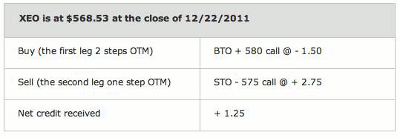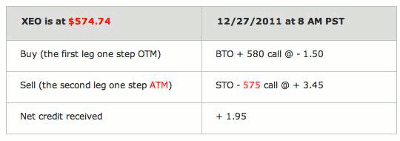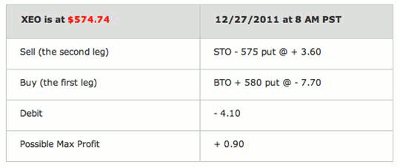A recent market example is used to illustrate the differences in risk between the bear put and bear call option strategies and considerations traders should take when choosing one over the other.
A bear put and bear call are both bearish vertical spreads. The first one is a debit spread, and the latter one is a credit spread. In which case would one make more sense to trade over the other? It depends on the implied volatility (IV).
If the IV is high, then it is better to be a seller (credit spread), but if the IV is low, it is better to be a buyer (debit spread). Let us focus on a specific underlying, the European S&P 100 Index ($XEO), and explore it in greater detail.
The reason why $XEO was selected is because it is a European-style option. We cannot possibly get assigned until expiration, even if we are dead wrong. However, this does not mean that we should ignore what the price action is doing, and where the supply zones are located.
At the time of writing (12/27/2011), there was possible resistance at $575. Now let us look at the IV reading for $XEO at $574.74 (resistance was at $575).
Looking at the table above, we clearly see that in the current environment, $XEO’s IV is only about 12 percentage points off the low versus being (41 - 18) 23% away from the 52-week high.
In short, a bear put would be the better strategy of the two. However, we said that we are going to compare the two, so let us start with the bear call spread.
Bear Call Spread
Knowing that there is possible resistance at $575, we can build a bear call spread around that level. In the case of the bear call spread, we focus on the leg that needs to be sold because that leg is the driver or anchor unit.
The bottom line is that we do not expect the $XEO price action to go over it. The figure below shows the time and sales of the two calls that we will use to make up our 575/580 bear call on $XEO.
To recap what is in the graphic above, I have created a table that explains what the spread actually is:
The next graphic also shows the time and sales of these same two call strike prices but on the morning of 12/27/2011. The last 575/580 bear call that day was done with 16 contracts and the premium received was greater than what a trader would have received when $XEO was trading at $568.53. The same trade done when XEO was trading at $574.74 brought in $1.95 since $XEO was trading much closer to the sold 575 call.
The table below, Figure 5, highlights in red the reason why the premium went up: the price is closer to the sold strike, so the 575 strike is now at the money and there is more inherent risk in selling it.
|pagebreak|Bear Put Spread
Having looked into a 575/580 bear call spread, let us move on to the 575/580 bear put spread. If we speculate that $XEO will not close above $575, then we could look at the in-the-money (ITM) puts. The option chain in Figure 6 shows what the values were at 8 am PST on 12/27/2011.
If we were to do the same option expiration cycle, December quarterly with three days left, the sale of the 575 put would bring in $3.60, while the purchase of the 580 put would be $7.70. The total spread would cost us (7.70 - 3.60) $4.10, while the spread is five points (580 put - 575 put). In this case, we are risking $4.10 to make 90 cents.
The rate of return is (0.90/4.10) 22% in the next three days. However, let us keep in mind that the bear put spread is not a credit spread where we pay less commission because we might be leaving some of the option to expire worthless.
With debit spreads, we are paying a total of four commissions, two to get in and two to exit. Those commission costs need to get subtracted from the profit made before one gets excited about the possibility of a 22% return in the next three days.
Assuming that one has a greedy broker who charges $25 for the spread entry and $25 for the spread exit (regardless if it is one contract or ten contracts), then that is $0.50 in total that needs to get subtracted from the profit of $0.90. Ouch!
If the 575/580 bear put spread was done with a single contract, the broker makes more than the trader does. The broker’s profit, with no exposure to the market, is $0.50, while the trader’s profit, with market exposure, is only $0.40. Go ahead make your selection: credit or debit.
Trading Conclusion
In conclusion, there is never a shortage of broker/dealers (B/D’s), but there is always a shortage of wise option traders. Keep in mind the commission cost when figuring out your possible rate of return. Make sure that it is subtracted from the profit regardless of whether the spread trade was a bear call or bear put; a credit spread or a debit spread.
The B/D always fattens their purse and it is never a zero-sum game (what one wins the other side has lost). The B/D’s are ultimately winners, so go after the lowest possible commission structure you can, but do not compromise the value of the data feed that you receive. After all, trading decisions are based on that data feed. Keep your trading in the green and do not oversize your positions.
By Josip Causic, instructor, Online Trading Academy




























